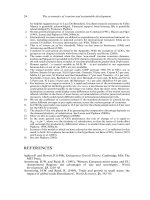THE ECONOMICS OF MONEY,BANKING, AND FINANCIAL MARKETS 150
Bạn đang xem bản rút gọn của tài liệu. Xem và tải ngay bản đầy đủ của tài liệu tại đây (33.29 KB, 1 trang )
118
PA R T I I
Financial Markets
The result is that the spread between the interest rates on the two bond types
has risen. Therefore, the differences between interest rates on corporate bonds and
Canada bonds (that is, the risk premiums) reflect not only the corporate bond s
default risk but its liquidity too. This is why a risk premium is more accurately a risk
and liquidity premium, but convention dictates that it be called a risk premium.
In Canada, coupon payments on fixed-income securities are taxed as ordinary
Income Tax
Considerations income in the year they are received. In some other countries, however, certain
government bonds are not taxable. In the United States, for example, interest payments on municipal bonds are exempt from federal income taxes, and these bonds
have had lower interest rates than U.S. Treasury bonds for at least 40 years. How
does taxation affect the interest rate on bonds?
Let us imagine that you have a high enough income to put you in the 40% income
tax bracket, where for every extra dollar of income you have to pay 40 cents to the
government. If you own a $1000-face-value taxable bond that sells for $1000 and has
a coupon payment of $100, you get to keep only $60 of the payment after taxes.
Although the bond has a 10% interest rate, you actually earn only 6% after taxes.
Suppose, however, that you put your savings into a $1000-face-value taxexempt bond that sells for $1000 and pays only $80 in coupon payments. Its interest rate is only 8%, but because it is a tax-exempt security, you pay no taxes on
the $80 coupon payment, so you earn 8% after taxes. Clearly, you earn more on
the tax-exempt bond, so you are willing to hold the bond even though it has a
lower interest rate than the taxable bond. Notice that the tax-exempt status of a
bond becomes a significant advantage when income tax rates are very high.
APP LI CAT IO N
Tax-Exempt versus Taxable Bonds
Suppose you had the opportunity to buy either a tax-exempt bond or a taxable
bond, both of which have a face value and purchase price of $1000. Assume both
bonds have identical risk. The tax-exempt bond has coupon payments of $60 and a
coupon rate of 6%. The taxable bond has coupon payments of $80 and an interest
rate of 8%. Which bond would you choose to purchase, assuming a 40% tax rate?
Solution
You would choose to purchase the tax-exempt bond because it will earn you $60
in coupon payments and an interest rate after taxes of 6%. In this case, you pay no
taxes on the $60 coupon payments and earn 6% after taxes. However, you have to
pay taxes on taxable bonds. You will keep only 60% of the $80 coupon payment
because the other 40% goes to taxes. Therefore, you receive $48 of the coupon payment and have an interest rate of 4.8% after taxes. Buying the tax-exempt bond
would yield you higher earnings.









